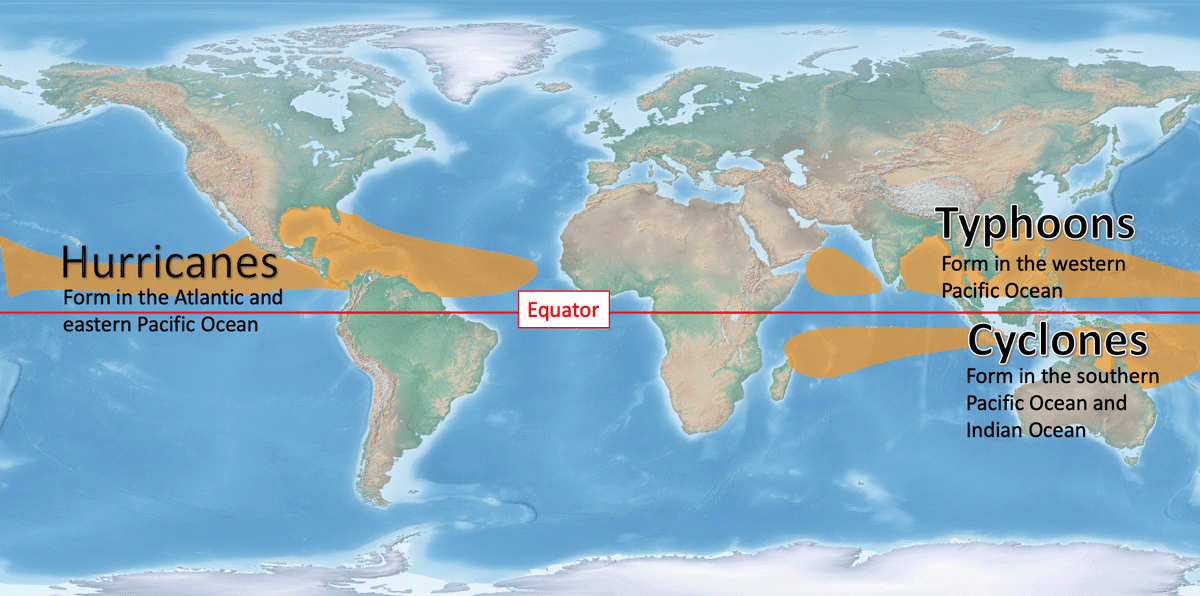Tropical cyclones are the strongest storms that happen on Earth. Tropical cyclones are storms that start near the Equator.
A tropical cyclone is a meteorological word that refers to a revolving, organized system of clouds and thunderstorms that forms over tropical or subtropical waters and has closed, low-level circulation.
In order to form tropical cyclones need warm, open ocean water. The top 50 meters needs to be at least 80 degrees Fahrenheit which is why tropical cyclones mostly form near the Equator.
Wind passing over these warm waters causes ocean water to evaporate and rise. The rising water vapor cools and forms cumulonimbus clouds. This rising condensation forms the start of a storm system. As warm air continues to rise, the clouds cluster in a spiral of winds, forming the tropical system.
Tropical weather systems have different stages of intensity, depending on the wind speeds. Not all tropical storms eventually develop into a tropical cyclone. The energy in a tropical cyclone comes from the vertical temperature difference in the storm system.
A tropical disturbance is a cluster of thunderstorm clouds. When wind speeds reach 25 to 38 miles per hour, the storm system is considered a tropical disturbance. Tropical disturbances lack a closed circulation.
A tropical storm happens when wind speeds reach at least 39 miles per hour and has a closed circulation. At this point, tropical storms will be assigned a name. In the northern hemisphere, the wind blows counterclockwise (west to east), while in the southern hemisphere, the wind blows clockwise (east to west). This phenomenon in tropical storm wind directions is called the Coriolis Effect.

A storm system is considered a tropical cyclone once wind speeds reach over 74 miles per hour. Depending on where the storm system develops, it will be called a hurricane, typhoon, or cyclone. Tropical cyclones can be as high as ten miles and up to 1,000 miles across.
What is the Difference Between Hurricanes, Typhoons, and Cyclones?
Tropical cyclones have different names based on where they originate from.
Hurricanes form in the North Atlantic and eastern Pacific Ocean. The official hurricane season is from June 1 to November 30 each year. Hurricanes can and do form outside of hurricane season.
Typhoons form in the western Pacific Ocean. The typhoon season is from May 1 to October 31. Tropical cyclones with sustained winds of more than 150 mph are referred to as “super typhoons” in the western North Pacific.
Cyclones form in the South Pacific Ocean and Indian Ocean. Cyclone season is from November 1 to April 30.

Hurricane Rating Scale
The intensity of hurricanes are rated based on wind speed known as the Saffir-Simpson Hurricane Wind Scale. Categories in this wind scale range from 1 to 5. Hurricanes in categories 3 to 5 are considered major hurricanes.
Category 1 hurricane:
- 74-95 mph
- 64-82 kt
- 119-153 km/h
Category 2 hurricane:
- 96-110 mph
- 83-95 kt
- 154-177 km/h
Category 3 hurricane (major)
- 111-129 mph
- 96-112 kt
- 178-208 km/h
Category 4 hurricane (major)
- 130-156 mph
- 113-136 kt
- 209-251 km/h
Category 5 hurricane (major)
- 157 mph or higher
- 137 kt or higher
- 252 km/h or higher
Typhoons and cyclones have rating scales that vary depending on where the tropical cyclones happen.
References
How does a hurricane form? (n.d.). NOAA SciJinks – All About Weather. https://scijinks.gov/hurricane/
Introduction to tropical cyclones. (n.d.). National Weather Service. https://www.weather.gov/jetstream/tc
